Birds,,,,,
Senior Environmentalist Mr. Jagath Gunawardhana’s Bird Watching data collection

කොරවක්කාගේ කලහකාරී චර්යාව / Aggressive behaviour of White-breasted Waterhen

තෙත්බිම් ආශ්රිතව ප්රධාන වශයෙන් හමුවන කොරවක්කා සාමාන්යයෙන් ඉතා කුලෑටි සහ පහසුවෙන් බිය වී පලායන්නෙකු ලෙස ප්රකටය.එසේ වුවත්,මේ වනවිට ඇතැම් නාගරික ප්රදේශවල මිනිසුන් කෙරේ බිය බොහෝදුරට අඩු කොරවක් ගහනයන් හමුවේ.එමෙන්ම මේ අතර ගෙවතුවල වසන සහ ගෙවතු වල කැදලි තනන කොරවක්කන් පවා හමුවේ.බොහෝ දෙනා එක්වර නොදකින චර්යා රටාවන්ද කොරවක්කන් සතුය.මින් එකක් නම් කලහකාරී හැසිරීම් වේ.සතුරන් මෙන්ම තම … CONTINUE READING
පුල්ලි වී-කුරුල්ලාගේ වැඩිවීම, පැතිරීම සහ ගිනි තණකොල

ශ්රී ලංකාවේ හමුවන වී-කුරුලු විශේශ පහෙන් සුලභතම විශේශ දෙකෙන් එකකු වන පුල්ලි වී-කුරුල්ලා (Scaly-breasted Munia / Spotted Munia) දුඹුරු පැහැති හිසක් සහ ශරීරයේ ඉහල කොටස්වලින් යුක්තය.ශරීරයේ පහල කොටස් (ලය සහ උදරය) සුදු පැහැති අතර එහි පිහාතු වල දාර දිගේ වැටී තිබෙන කලු පැහැය නිසා කොරල රටාවක් ලෙස පෙනේ.ම්එරට පහතරට තෙත් සහ වියලි කලාපයන්හි මෙන්ම ඉතා … CONTINUE READING
මල් පිලිහුඩුවාගේ (Common Kingfisher) ආහාර පිරිනැමීමේ චර්යාව

බොහොමයක් පිලිහුඩු විශේශ ප්රජනන සමයේදී විශේශිත වූ චර්යාවන්හි නිරතෙ වෙති.මේ අතරට නාද කිරීම්,හඹා යාම්,රැඞුම් ඇතුලත් වේ.මොවුන් පෙවන තවත් විශේශිත චර්යාවක් නම් පිරිමි පක්ශියා විසින් ගැහැනු පක්ශියා වෙත ආහාර පිරිනැමීමයි.මේ ඡායාරූපයෙන් පෙනෙන පිරිමි මල්-පිලිහුඩුවා ප්රජනන චර්යාවන්හි කොටසක් වන ගැහැනු පක්ශියාට ආහාර පිරිනැමීමේ නිරත වී සිටි අතර තමන් අල්වාගන්නා ගොදුරු සියල්ල ගැහැනු පක්ශියා සොයාගොස් පිරිනමන ලදී.බොහෝවිට ආහාර පිරිනැමීම … CONTINUE READING
කෝපි කුරුල්ලා / Tickell’s Blue Flycatcher / Orange-breasted Blue Flycatcher (male)

It is about 14 c.m.(5 ½ inches) in length, or about the size of a House Sparrow.In males, upper parts are dull dark blue with a brilliant cerulean blue forehead and line above eyes. Lores and face black. Chin, throat and breast a dark, bright orange tinged with burnt sienna brown.In females, upper parts are … CONTINUE READING
දුඹුරු මැටි-කොකා / කුරුඳු මැටි-කොකා / Chestnut Bittern / Cinnamon Bittern

This is one of the resident bitterns in Sri Lanka,and it does not have a migratory componest as in the Yellow Bittern and the Black Bittern.It has a chestnut (or cinnamon) brown body,as implied by the names.The male is a bright chestnut while the female is browner with well-defined lines along the neck and breast.This … CONTINUE READING
දියවන්නා ඔයේ ගැට කිඹුලන් Saltwater Crocodile / Estuarine Crocodile (Crocodylus porosus) අතීතයේ පටන් ඉඳ හිට වාර්තා විය.මා 1988 වසරේ සිට ඉඳහිට ගැට කිඹුලන් දැක තිබේ.මොවුන් එකල දක්නට ලැබුනේ පායන කාලවල පමනකි. නමුත්,මීට වසර කිහිපයකට පෙර දියවන්නා ඔය සහ ආශ්රිත ජල මාර්ග ගැඹුරට හෑරීමේ ව්යාප්රුතිය ආරඹ්හ කරන අවස්ථාවේ ජල මාර්ග ගැඹුරු කිරීම නිසා කරදිය ඉහලට ගලා ඒම … CONTINUE READING
රාජාලීන් සහ පොල්කිච්චන්-සත්ව චර්යාවන්ගෙන් අපටත් යමක්

රාජාලීන් ඉතා විශාල වපසරියක පියඹති.ඔවුන් අහසේදී තවත් රාජාලින්, උකුස්සන් සහ අන් පක්ශීන් සමග ගැටුමකින් තොරව තම පියාසරිය සිදු කරති.ඔවුනට පහසුවෙන් මෙන්ම අවශ්ය විට ඉතා වේගයන් මෙන්ම අහසේ විවිධ මට්ටම් වලද සැරිසැරීමේ හැකියාව ඉතා හොඳින් තිබේ.පොල්කිච්චන් පොලොවේ ඉතා කුඩා භූමි ප්රදේශයෙක් තම නතු ප්රදේශය ලෙස දිගටම පවත්වා ගනී.ඔවුන් එම නතු ප්රදේශ් ඉතා දැඩි පරිශ්රමයකින් සහ කලහකාරී … CONTINUE READING
කහ කුරුල්ලා / Black-hooded Oriole / Black-headed Oriole

The nest is a characteristic small and deep hammock, hung between two small and thin branches high up in a tall tree. It is made mainly out of fibrous materials and it is seen that pieces of leaves, twigs and bark are incorporated in to it. This make it well-camouflaged and difficult to see apart from … CONTINUE READING
කලු කොකා / කලු මැටි කොකා / black bittern (Ixobrychus flavicollis)

This is the largest member of the genus and the largest of the bitterns seen in Sri Lanka too.It has black upper parts,and a characteristic orange-yellow or raw sienna colored streak on the sides of the head and has long broken streaks of the same color,yellow or yellowish white along the nack to the breat … CONTINUE READING
වන හලන්පෙන්දා / වන හැලපෙන්දා / Forest Wagtail—The perching habit

The Forest Wagtail has a habit of perching on branches readily for several reasons,though it is usually a ground dwelling bird.It always spends the night in a communal roost and all birds tend to fly off in the evening to these sites. In departing for the night roost, it has the habit of first ascending … CONTINUE READING
බලල් සේරුවා / Pheasant-tailed Jacana—Sheltering eggs from mid-day heat

This bird,probably a male,was standing in a position to let the shadow fall on the eggs.It never sat on the eggs but always kept this position, to keep the eggs in shadows and to prevent the mid-day sun to fall on the eggs directly.The cluch of eggs can be seen between the legs of this … CONTINUE READING
රෑ කොකා / රෑ කන-කොකා / Black-crowned Night Heron —juvenile

The juvewnile stages of this bird is quite different from the adult and often looks like different birds.This photograph shows a juvenile just out of the nest.It has dark brown streaks on the head,neck and underparts while the dark brown wing coverts have pale brown or yellow blotches which are prominently seen.The crown is dark … CONTINUE READING
Common Sandpiper — Arrival for the season (2018/2019)
This bird has arrived for the 2018/19 Migratory season and can be seen in suitable wetland habitats.It is seen that this bird has arrived during the usual arrival period this time. This is one of the earliest Winter Migrants to arrive in Sri Lanka and are still in breeding plumage when they come back. The … CONTINUE READING
යක්-එරබදු (Erythrina fusca)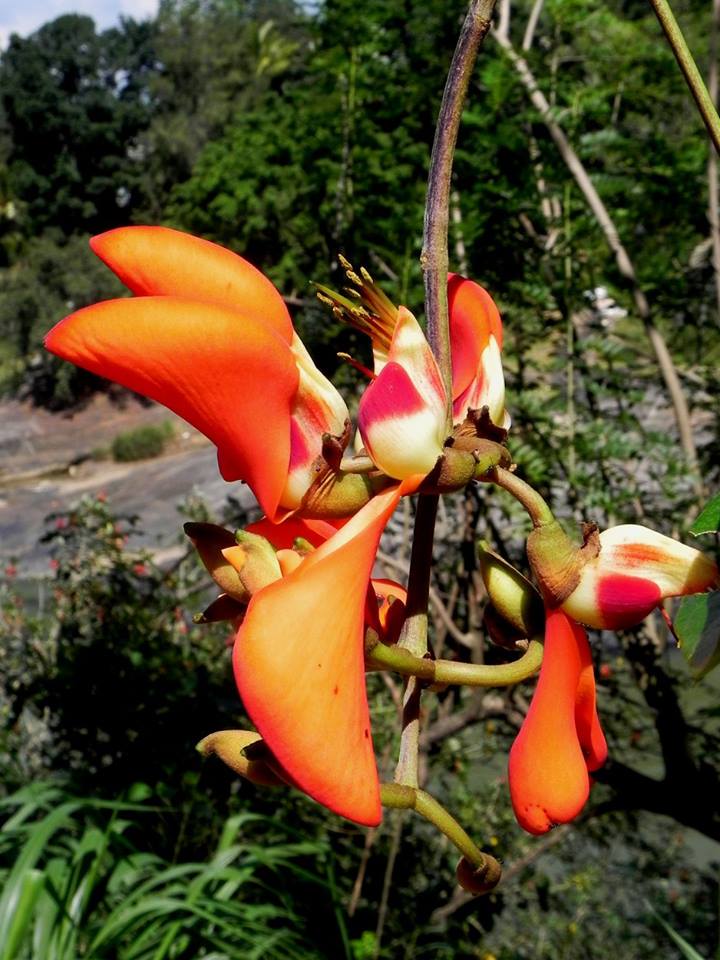
මෙරට ස්වදේශික එරබදු විශේශ දෙකෙන් වදාත් දුලබ යක්-එරබදු එම නම ලබා තිබෙන්නේ මෙහි කඳන් වල සහ අතුවල අධික ලෙස කටු පිහිටීම නිසා විය හැක. අනෙක් එරබදු වලට වඩා වෙනස් හැඩයෙන් යුතු,එනම්, දිගැටි ස්වරූපයෙන් යුතු සහ නිල්-කොල පැහැති පත්රිටකා වලින් යුත් පත්රන දරන මේ ශාකය සෙමෙන් වර්ධනය වන්නකි.මේ ගසද උසින් අඩුය.සාමාන්යමයෙන් ජල මාර්ග ඉවුරු වල හමුවේ. … CONTINUE READING
Cat’s Claw Vine (Macfadyene unguis-cati)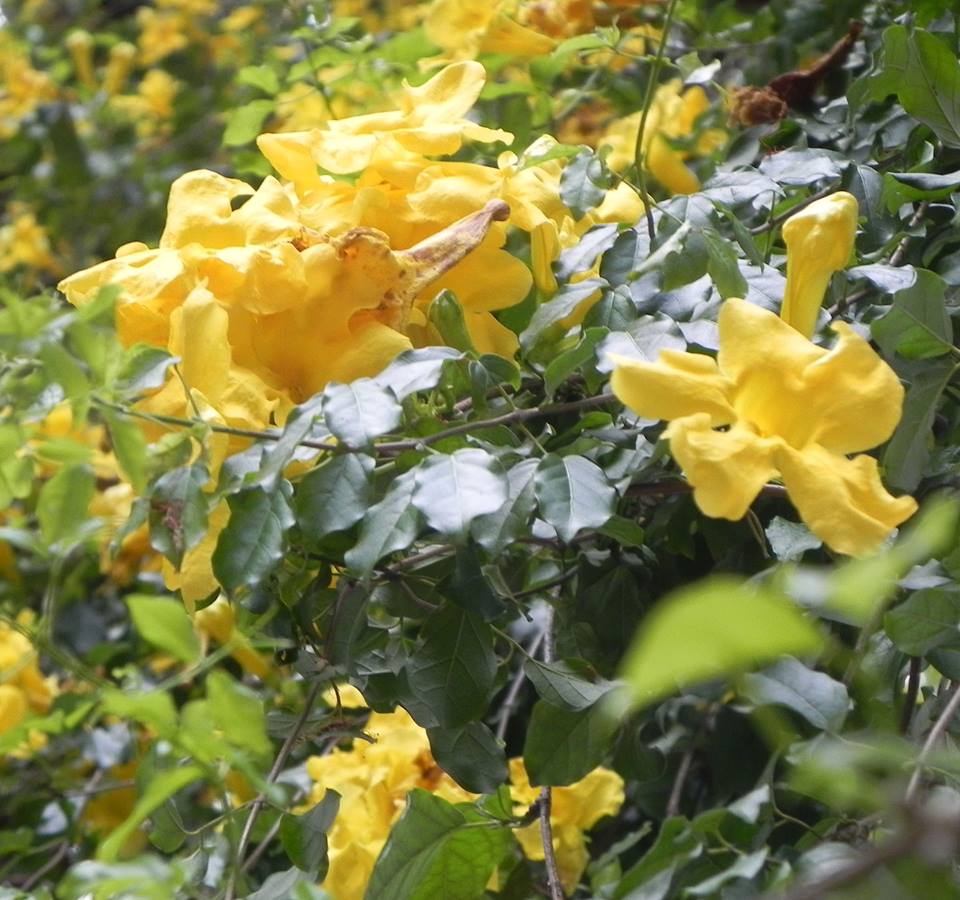
This high climbing woody vine reaches the canopy of trees and forms a cascade of hanging down branches. These hanging branches get covered with golden yellow flowers during the flowering season.It is a very pretty sight,especially when the vines are large and cover one large tree or a grove of trees.This phenomenon,seen in the premises … CONTINUE READING
කොහාගේ(Asian Koel) අලුත් අවුරුදු නාදය
මෙරට හමුවන සුලභම නේවාසික පක්ශියෙකු වන කොහා හෙවත් කොවුලා,සිංහල අලුත් අවුරුදු සමයේදී තම ලාක්ශනික කන්කලු නාදය නගයි. මේ නාදය කරනුයේ පිරිමි සතුන් පමනක් වන අතර, එය මේ පක්ශියාගේ ප්රජනන සමය තුල පමනක් සිදු වන්නකි.නමුත්,කපුටු කූඩු වල තම බිත්තර දමන කොහාගේද ප්රජනන සමය මේ වනවිට කපුටන් මෙන්ම දිගු කල පුරා සිදු කිරීමට සමත්ව තිබේ.පසුගිය කාලයේ කල … CONTINUE READING
Mistflower (Agerantina riparia)
This Invasive Alien Species is found in the higher elevations of the hill country and is found mainly in the Nuwara Eliya District.It is also found in the adjoining areas in the Badulla District too and in the Knuckles Range in the Matale District. Unlike in Knuckles Range, where it is mostly confined to the … CONTINUE READING
Lesser Whistling Duck / Lesser Whistling Teal
This bird inhabits a wide variety of wetland habitats such as marshes, reed beds, paddy fields, tanks, lagoons, streams and canals and is always found in places that have grasses, reeds and water plants such as lotus and water lilies, avoiding areas with a large expanse of open water. It spends most of the day … CONTINUE READING
2018 World Sparrow Day (WSD)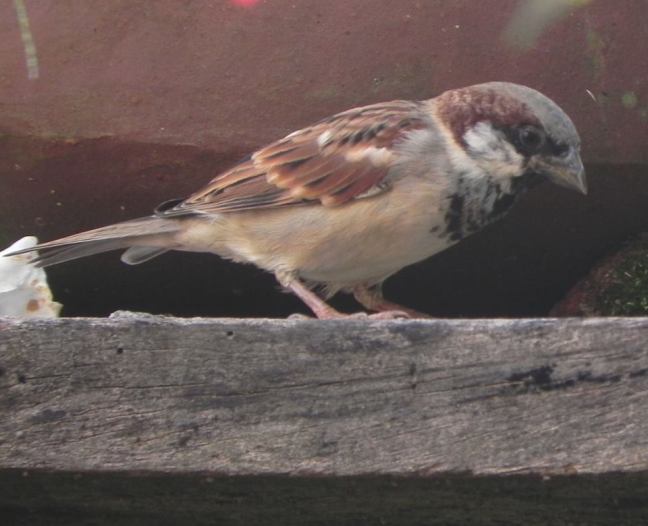
Today (March 20th) is the World Sparrow Day(WSD),declared in order to draw much needed attention to the declining of the sparrows of the world and to harness popular support in the efforts needed to conserve them. This day was initially named as the World House Sparrow Day (WHSD) in 2010 but was broadened to include … CONTINUE READING
Comparison between similar flycatchers—Brown-breasted and Asian Brown Flycatchers
The Brown-breasted Flycatcher / Layard’s Flycatcher (left) is quite similar to the closely related Asian Brown Flycatcher and some have difficulties in telling them apart. But, the differences in size, plumage differences and differences in habits help to make a positive identification. The Asian Brown Flycatcher is smaller in size, has gray-brown upper parts, lacks … CONTINUE READING
Indian Cormorant—Breeding features
In this species,the changes during the breeding season are confined to the head.The tree features that change during the breeding season are very clearly seen here.
They are:
* The grey or blackish gular pouch.
* Blue eyes.
* Tuft of white feathers behind and below eye.
Jagath Gunawardana Attorney at Law
Emerald Dove—Key features
• It is about 27.00c.m.( 11inches) long, or slightly larger in size than a Common Mynah. •Forehead white, extending back in to a white brow and an eye-ring. •The top of the head and nape grey, and this grey color extends down the hind neck up to the back. •The sides of the head, the … CONTINUE READING
Red Pierrot (Talicada nyseus)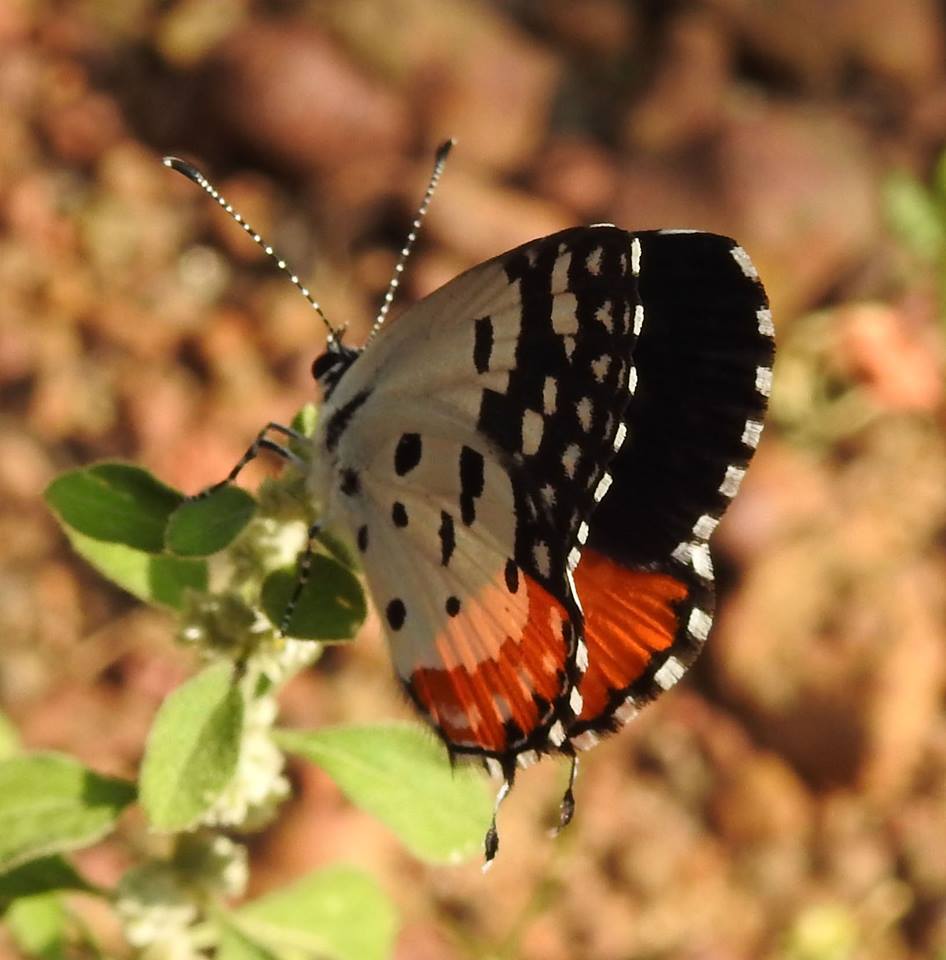
This small butterfly is a common inhabitant of home gardens and scrub lands. The upper side is black,with the posterior of hind wings orange red.The under side shows vermillion red,black and white. It is a slow flier that can be seen inhabiting the low grasses and plants,and even alighting on the ground at times. It … CONTINUE READING
Loten’s Sunbird—Male in display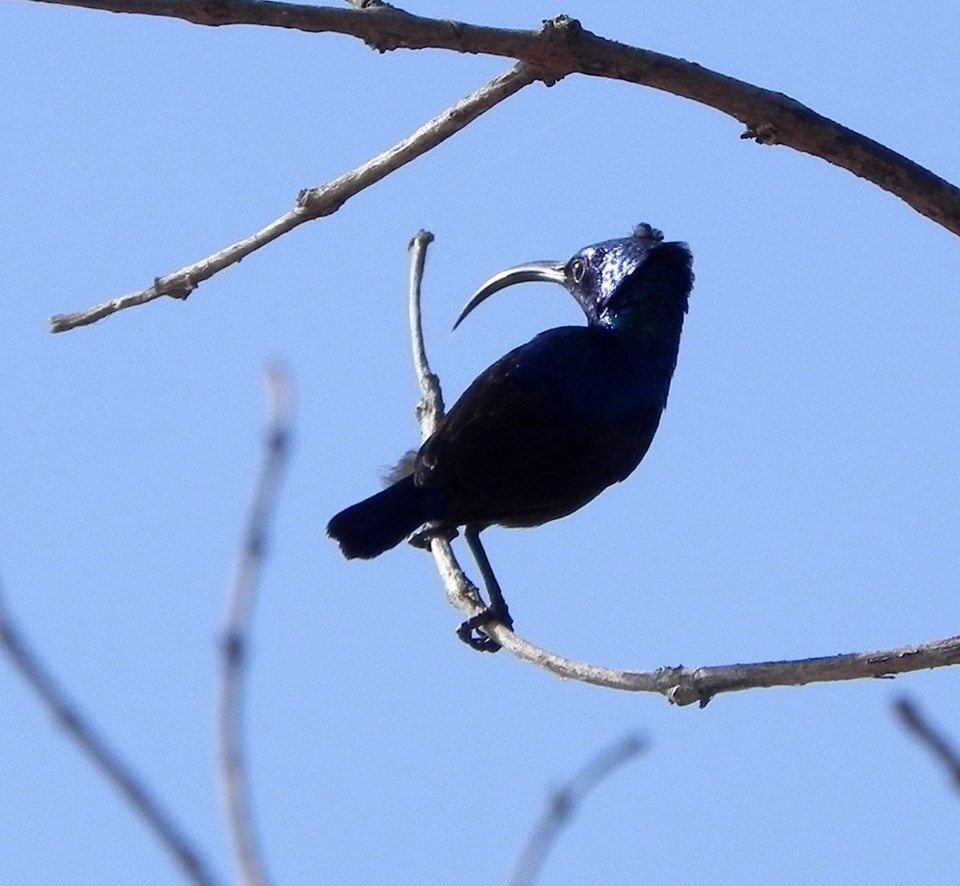
This male was displaying,with loud calls and adopting different postures.
It was also seen fluffing out the nape feathers to make a halo-like disk of feathers.
Jagath Gunawardana Attorney at Law
දිය මෙනේරි / Benghal Dayflower/ Whiskered Commelina (Commalina benghalensis)
A trailing herb with fleshy leaves which have Wavy edges. The flower is a deep royal blue,and has the most intense blue of all species of Commalina found in Sri Lanka. It is common in wet places in both low-country Wet and Dry Zones.However,it has become quite rare in many paddy fields due to the … CONTINUE READING
Black-winged Stilts in Wet Zone—Four decades later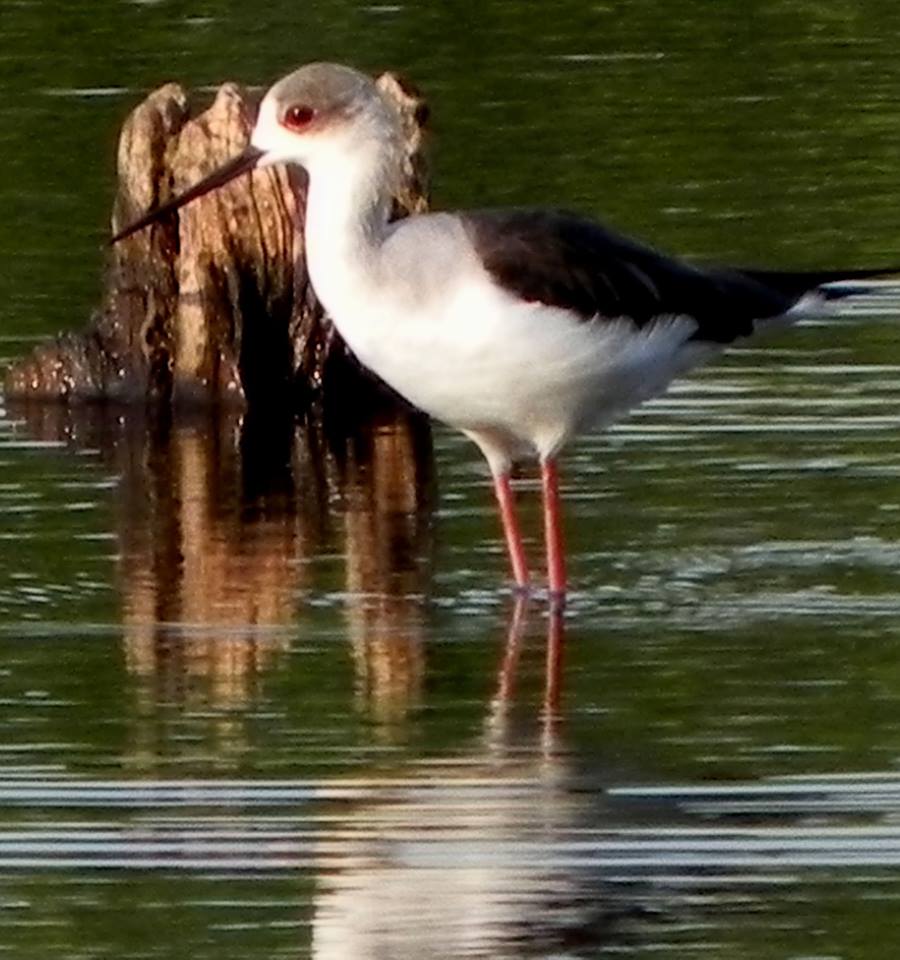
The Black-winged Stilts are usually seen in the Wet Zone only during the Winter Migratory season and some think they are migrants due to this reason although the prevalent view is that they are internal migrants from the Dry Zone. The first observations of this in the Wet Zone were by Mr.Rex I. De Silva in … CONTINUE READING
Water Monitor–menace to breeding aquatic birds
It is seen that this animal plays a major destructive role in the breeding of aquatic birds by raiding the nests built on shrubs and low trees to predate on the eggs and young. It can climb well,even on rather slender branches,despite the bulk.Thus it reaches most nests during a raid and the increased population … CONTINUE READING
Asian Brown Flycatcher
This winter migrant is seen to be solitary and territorial during the stay in Sri Lanka and birds in adjoining territories can be heard answering each other, usually in the mornings. They are peaceful and do not show any aggression either towards the same species or others. Each bird keeps to its own territory and … CONTINUE READING
Whimbrel(Numenius phaeopus)
A large wader with a long downward curved beak, resembling a smaller version of the Curlew. It is identified easily by the light eye-brow or supercilium, bordered by a dark eye-stripe and by the smaller size and shorter beak from the Curlew. This bird can be seen along the coastal areas of the Dry Zone … CONTINUE READING
Sanderling(Calidris alba)
This bird has a stocky body,a large head with a thin long beak. In Winter (non-breeding) plumage,it has a pale body,the upper parts showing a grey color and underparts being a bright white in color.The beak and legs are black. It is very active and agile and moves to and fro with the waves,always keeping … CONTINUE READING
Emerald Dove
This is the most colorful and the most brightly colored of all the pigeons and doves found in the country. The red and green colors in its body provides a complimentary contrast, heightening the intensity of both colors that make it to shine and shimmer in the dull undergrowth which is the usual habitat of … CONTINUE READING
Whiskered Tern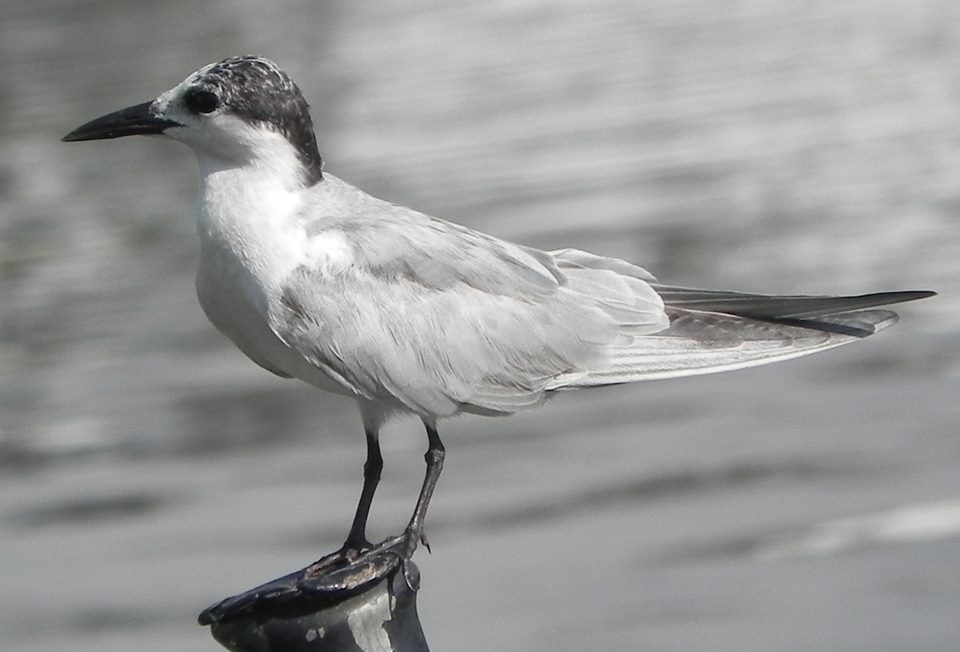
It is seen in both low country Wet and Dry zones and is one of those terns referred to as “river terns,” owing to the habit of moving inland and not confining themselves to the coastal habitats like those referred to as “sea terns” do. It spends much of the time flying actively over water … CONTINUE READING
Black-headed Ibis —Red Patch on hindneck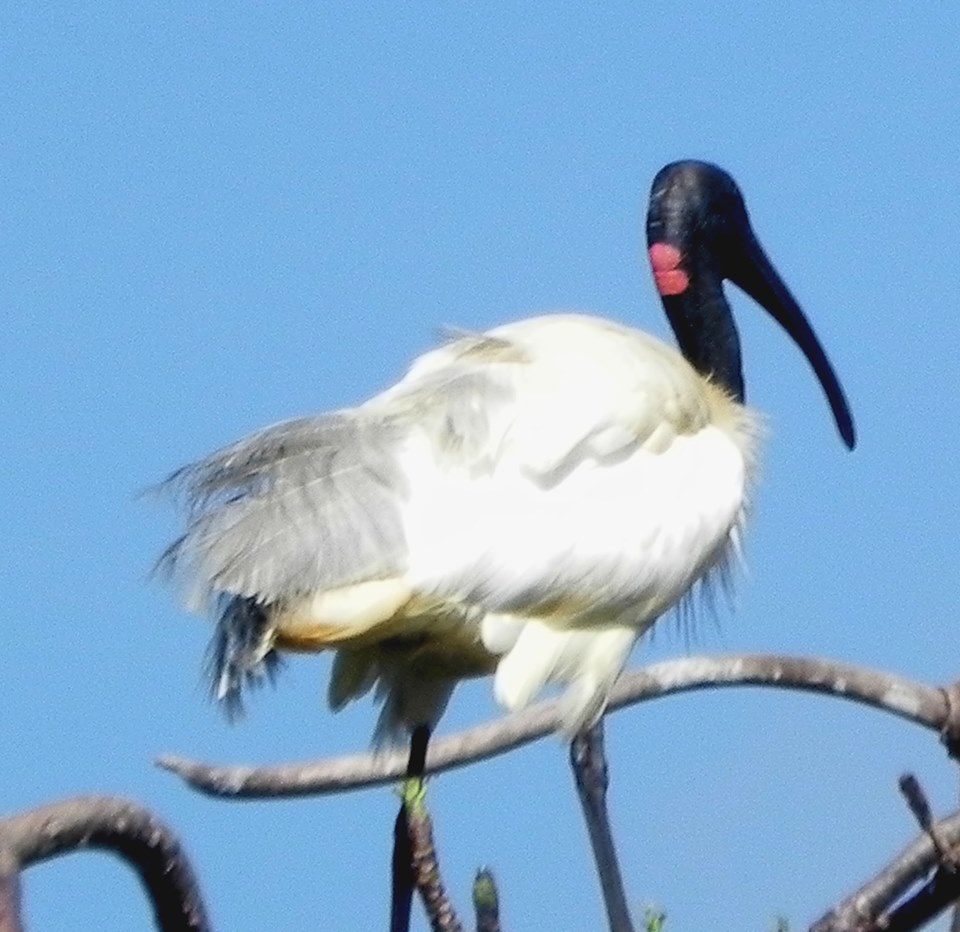
It has been observed by me that some individuals of this species develop a conspicuous red patch or patches on the hindneck during the breeding season. The breeding season of this species has begun and several individuals with red hindneck patches were observed among them. This particular individual had a quite large patch on hindneck … CONTINUE READING
Oriental Honey-Buzzard — Watch out for arrivals
This is yet another bird that has both resident and migrant populations and it seems that most birds seen in the Low-country Wet Zone are migrants.This is seen by their presence in many areas during the migratory season. It is seen that this increase in numbers and range is sen for the past two weeks. … CONTINUE READING
Birds watchng
Large Egret– Coming in to breeding plumage This bird shows well-developed back plumes,a beak that has almost become black,and pinkish tinge on tibia(the upper part of the legs). In full breeding plumage,it shows a black beak with a viridian green area before the eye,well developed back plumes and rose red tibia. Whimbrel(Numenius phaeopus) A large … CONTINUE READING
Pale-billed Flowerpecker/ Tickell’s Flowerpecker/ Small Flowerpecker
This bird,found commonly in all parts of Sri Lanka, holds several records. ** It is the smallest bird found in Sri Lanka ,being about 8.00 c.m.(3.2 inches) in length ** It is the smallest endemic sub-species of bird found in Sri Lanka. ** It is also the smallest species of bird bird found in India,thus … CONTINUE READING
Rosy Starling / Rosy Pastor
This is a regular winter migrant that is seen in both Wet and Dry Zones. In the winter (non-breeding) plumage,adults have a black head and breast,black flight feathers and greyish-pink back,lower breast and abdomen. It is seen in flocks that alight on the ground,on smaller trees and shrubs.
Sanderling(Calidris alba)
This bird has a stocky build with an overall pale body,the upper parts being grey and the underparts a bright white in color.The beak and legs are black. It is very active and agile and moves to and fro with the waves,always keeping a pace ahead of the oncoming waves.This bird is often seen in … CONTINUE READING
Indian Cormorant(immature bird)
This bird has a whitish breast and abdomen with the body being predominantly brown.The beak is a light yellowish grey with a prominent yellow gape,and the chin and throat are white. The eyes are blue-green as in non-breeding adults.
Indian Pond Heron feeding on a Centipede(Patteya)
This was a chance observation I made,while watching this bird which has come in to full breeding plumage. It suddenly turned and captured this centipede from the ground,adjusted the struggling creature between the mandibles(see head photo) before swallowing it.
Wood Sandpiper
This bird is a winter visitor that is seen mostly in the Dry Zone but is also seen in Wet Zone in smaller numbers.It has been observed by me in Wet Zone habitats such as Bellanwila-Attidiya Sanctuary,Kotte-Sri Jayawardanapura Sanctuary and the Talangama Tank. It is an active bird that walks about searching for prey and … CONTINUE READING
Green Imperial Pigeon in Nugegoda
It has been seen that this bird is seen in different areas in Nugegoda,including the town area and Wet Park. This photograph was taken in Wet Park where there was a flock of six birds. This bird,the largest of pigeons found in Sri Lanka,has been steadily extending the range of occurrence in the low country … CONTINUE READING
Little Egret in full breeding plumage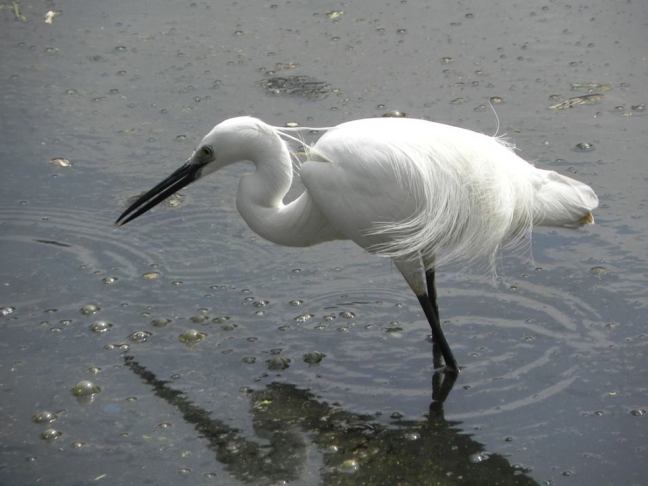
Little Egrets are coming in to breeding plumage and some have already got full breeding characteristics. They are long streamers from the back of the head,and plumes on breast and back.In this species the beak is always black. This shows a Little Egret showing the characteristics of the breeding plumage.They are: * The streamers on … CONTINUE READING
Oriental Magpie Robin
This is one of the commonest and most widespread birds in Sri Lanka, and is one of the best songbirds inhabiting this country. For many, it is the only familiar songbird and the loud and melodious calls of the males are heard these day, from the wee hours of the morning till it is quite …CONTINUE READING
Pheasant-tailed Jacana in breeding plumage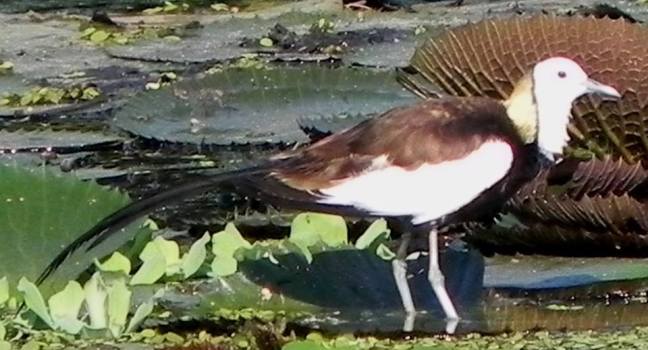
The breeding season of this bird is long-drawn and extends from January up to June. The breeding period is now quite long and extended and is quite longer in duration than has been given in literature. Some individuals can be seen in the breeding plumage even in December indicating a further extension. In this bird, … CONTINUE READING
Yellow Bittern–Picking prey off a branch
This is a bird that is known to feed on aquatic organisms.However,it has a liking for dragonflies off bushes if they get an opportunity. This Yellow Bittern was seen stabbing up by extending the neck suddenly to grab a dragonfly (Asian Groundling) that was on a low-hanging branch. The prey got away,but it is interesting … CONTINUE READING

